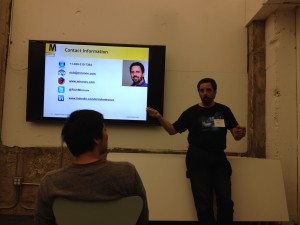Rich Mironov led the discussion at the most recent SF StartUP ProductTalks. My introduction to product management was Rich’s book The Art of Product Management, so it was great to see him talk!
A huge thanks goes out to Rich for speaking and curating the discussion.
Below are my notes from Rich’s talk and the discussion. It was also interesting to see the folks looking for work and those who had open positions in their companies, although as Rich said – “you’re all looking for unicorns”, as in we are all looking for very particular people for our jobs and not filling roles with the available people when they are more than competent. That was an interesting takeaway for me.
On to the discussion notes:
To get things started Rich asked the attendees for some topics they wanted to learn more about, the results were:
- Product Owner vs Product Manager (16 votes)
- Technical Skillset (15)
- Working with Developers (8)
- How to transition from project management to product management? (7)
- Certifications (2)
What does a product manager do? (Slide deck)
(Slide 2)
Product Managers sit between three groups that don’t talk together, sit together, or have a common language. Executives, Marketing & Sales / Markets & Customers, Development
Development
- PM Input – business requirements, guidance, market information, priorities, user stories, personas
- Dev Output – software
- If you are in development you are often blind to the interactions that PM has with the rest of the organisation.
Marketing/Sales & Market/Customers
- PM Input: segmentation, pricing, demos; output: feedback
- sales and marketing communicates what the customers provide
If you poll sales people:
- why we win sales: awesome salespeople
- why we lose sales: product sucks, too expensive, not enough collateral
Sales people have a ‘stack depth’ of one – they only remember what the customer asked for in the last meeting.
As PM people we need to talk to customers/prospects directly.
Executives
- PM Input – market models, strategy, forecasts, etc
- Exec Output – vision, budgets, staff, targets
The ideal candidate for a Product Management position is someone who has been in each of these roles:
- They will have been in development or know enough to call BS. However, engineers who move into PM often find this hard as making a more “correct argument” doesn’t float.
- “If you’ve never ridden in a car with someone who has a quota you don’t know sales”.
- Executives care about keeping the company afloat.
Three different groups, with different skills and different languages. Hard to find this within one person, so you can try to build a team that does have those skills. Product Management is a hard job for anyone – “smart people go find something else to do eventually”.
Agile Planning Onion – Mike Cohn: Daily, Sprint, Release, Product, Portfolio, Strategy. Product Managers live in the middle – three to twelve month period – and bridge the strategy that Executives have laid down with the limited set of staff the organisation has.
Product Owner vs Product Manager
(Slide 5)
Does it depend on the company?
People from the Agile space – Product Owners – often don’t know how to sell and market products or how to get those products into the market successfully. Further, they often don’t know how to EOL a product or support the product when it is in production. They know how to build products.
Agile people often feel if you make it they will come, why won’t the world buy it. Emergent business model. We don’t know who we will sell this to, we’ll figure it out on the way.
The Product Manager is the wrapper, the overarching strategic folks that listen to customers/support engineers/sales people/developers/executives, and then set a direction, plan and price and market the product.
“Eric Ries brilliant” – taken direct marketing science and introduced to engineers as customer development. (as an aside we’ve got Eric Ries in conversation at Atlassian Summit 2012)
Product Owners Calendar
(Slide 8)
Lacking customer interaction. The Scrum definition of Product Owner doesn’t define anytime to sit with customers except for the time that customers join the demo and planning each sprint. Don’t confuse the customer showcase for the entire market.
If you are the PO that doesn’t get out of the building you failed. Yet Scrum training expects you to sit with the team and be able to answer all of their questions about the customer/problem.
“get out of the building” – Steve Blank
Agile will consume much more product management time – which is good. But if all you do is sit with your team – EOJ – End of Job.
A “small p product owner” lacks real input from execs, customers, etc and that is a failed model.
Most Product Owner failure is due to not spending enough time observing customers, or they don’t know how sales and marketing work, or we promoted them from development and they are missing pricing, packaging, EOLing experience, competitive dynamics, and more.
Generally a promotion from engineering to PM doesn’t have good connections to sales, marketing, support – all of which are a great source of input. Don’t just promote someone who is a good engineer to a PM – you lose a good engineer and don’t necessarily get a good PM.
Another challenge for the Product Owner is that they haven’t spent enough time with company strategy – optimise locally vs optimising a company wide strategy. Or you have a solo product manager who doesn’t prime the backlog – “build what I meant” – the PM who doesn’t know Agile.
So, really there should not be a split between the PM/PO roles. Fewer more experienced people works best.
Waterfall is conceptually easier as you believe in the fiction that the projections are correct, until 6 weeks before launch. A lot of companies run on Waterfall at the top and Agile at the bottom, and there is something bad that happens in between.
Technical Skillset
What are the weapons that a PM needs to have to work with engineering?
- If you are not very technical don’t sign up for a technical product management job until you’ve built the technical foundation.
- Engineers listen to you a whole lot more when you come from an Engineering background as you can call BS.
- A technical team will write you off in a second in a highly regulated environment (finance/medical). Engineers will know if you are talking BS.
- Consumer apps need a PM with a lot of taste, they need to know what the demographic cares about. Tech background is not as important.
- Hire MBA’s in their second job out of college – so they no longer think they are the boss. Great hires if they have a technical background.
- Helps to have a friend in the development team, even if not in the same company. You can ask the questions without showing too much weakness.
- How can you gain technical skills? Start hacking. Build it now. Startup weekend.
How to transition from project management to product management?
The job of a project manager is to get done the things we’ve promised to get done when we know we don’t have enough time or resources – how can we shave the edges to ship the thing we promised to ship? Can we shorten the QA cycle? Inward looking optimisation.
If I am on the product management side I ask what features to I drop to make the date? Outward looking optimisation.
Start spending more time with customers. Think about the pricing problem, competitors.
It is just as hard to go back the other way.
Better yet, build a team with complimentary skills. Have trust and happiness.
Resources:
- Rich Mironov
- What does a product manager do? Slides in PDF
- The Art of Product Management – Rich Mironov






Nick, thank you for the excellent notes on Rich’s presentation! I’ve included your post in the recap from the event that covers background, people’s answers, Rich’s slides & relevant tweets: bit.ly/KF38dA Best, Cindy
Brilliant, thanks Cindy!